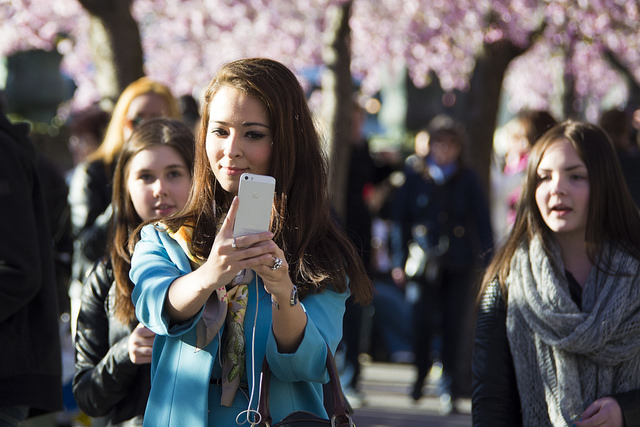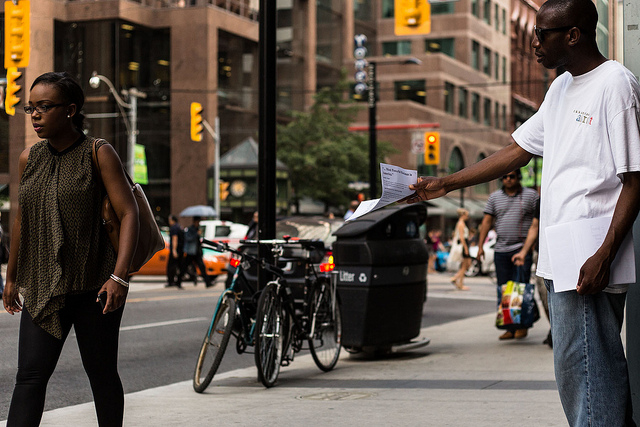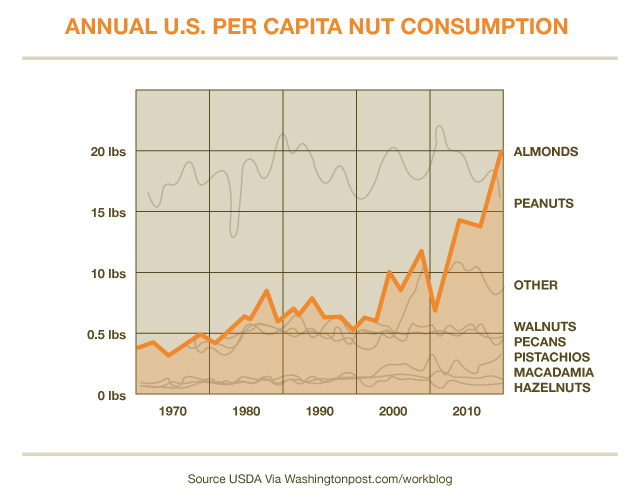Unlock the Magic in Your Story Now
Get the Free 20 questions to Ask Before Launching Your Idea workbook when you sign up for occasional updates.
Get the Free 20 questions to Ask Before Launching Your Idea workbook when you sign up for occasional updates.
Articles filed in: Storytelling
The Myth Of The Captive Audience
filed in Marketing, Storytelling, Strategy
 Maybe you read the recent article on Entrepreneur.com about digital advertising trends that included the following passage?
Maybe you read the recent article on Entrepreneur.com about digital advertising trends that included the following passage?
“Mobile video viewers are what you might call a “captive” audience. When TV commercials begin, people look down at their phones. On the bus or subway, people focus on their digital screens instead of the ads passing by in the cityscape. When radio ads begin, people change the station. However, when people are already looking at their smartphone, nothing is going to distract them. Use mobile video ads to take advantage of this undivided attention.”
Two phrases jump out ‘captive audience’ and ‘take advantage’.
Isn’t it time we stopped using language that alludes to deceit and domination when we think and talk about how to engage with our audiences and our customers?
These are the people who buy the things we make. They are the people who give us a reason to get up in the morning. They keep the lights on at our offices and shoes on our kids’ feet. They have needs and hopes and dreams beyond our sales goals and quarterly projections. Their attention, support and loyalty are on loan to us.
And they do have choices—more now than ever.
Our job should never be to take advantage of people who have no choice. Where’s the fulfilment in that? Our job is to understand and give to the people we want to matter to. This is the way to patiently build a sustainable business and a legacy. It truly is possible and it’s worth it.
Nothing worthwhile, lasting, impactful or loved was built by taking advantage of people who had no choice but to stand there and take it. Nothing.
Image by Chris Guillebeau.
What’s Your Customer’s Why?
filed in Marketing, Storytelling, Strategy
 It’s true that people buy from companies they like. We feel an affinity with some brands and not others and our purchasing decisions reinforce our values. The Internet has given rise to a new kind of savvy, connected customer. She seeks out purpose driven brands whose ideals resonate with hers.
It’s true that people buy from companies they like. We feel an affinity with some brands and not others and our purchasing decisions reinforce our values. The Internet has given rise to a new kind of savvy, connected customer. She seeks out purpose driven brands whose ideals resonate with hers.
While it’s important to spend time working out why your business exists beyond profit making and how you create difference for your customers, it’s equally important to do the work of understanding your customer’s motivations, frustrations, values, hopes, dreams and desires.
How can you hope to sell something to someone if you don’t know who she is and how your purpose intersects with hers?
Image by Patrik Nygren.
A Category Of One
filed in Marketing, Storytelling, Strategy
 The sign was in the perfect spot—right next to the traffic lights at a notoriously slow moving T-junction, to maximise the number of people who would see it. The message was clear:
The sign was in the perfect spot—right next to the traffic lights at a notoriously slow moving T-junction, to maximise the number of people who would see it. The message was clear:
“NEED A WEBSITE? 04040404040”
What’s also clear is that the people who call are not likely to be the customers that the web designer is hoping for. It’s hard to do meaningful work when you try to appeal to everyone, because you end up competing on price instead of quality, hours clocked instead of value delivered.
Anyone can build ‘a’ website. It takes guts and talent and commitment to become known as the go-to person for ‘the’ website.
Your work is defined by the story you are asking your customers to believe about you every day.
You are in control of the story you tell.
How you tell that story gives you the opportunity to choose what you do and who you do it for.
Why not aim to be in a category of one?
What’s Your Email Marketing Strategy?
filed in Marketing, Storytelling, Strategy
 Digital is fast and cheap. Now we can save a dollar or two on stamps that are no longer needed, plus the time and energy spent licking them and stuffing envelopes. We don’t even need to walk to the post box to mail our messages. Because it’s easy to reach anyone with an email address we sometimes take less care to craft those messages than we should.
Digital is fast and cheap. Now we can save a dollar or two on stamps that are no longer needed, plus the time and energy spent licking them and stuffing envelopes. We don’t even need to walk to the post box to mail our messages. Because it’s easy to reach anyone with an email address we sometimes take less care to craft those messages than we should.
Mr X has spent three years working on his project. More than a thousand days of planning, innovation and development have gone into shipping it and yet he’s probably spent ten minutes crafting the first and only email the reader who forwarded this has ever received from him.
[Actual email with names and details changed. Please DO NOT USE this template.]
Hi —————,
We’ve just launched our product! It’s an xyz.
This is what it does.
Check it out [link].
Our website is live and we need your help.
You can pre-order for $X, and if you like it, please share this as far and wide as you can.
Feel free to give us some love on social media too.
Twitter [link]
Facebook [link].
Thanks!
Mr X
———————————————————————————————————————————————————————————————————————————————————————————
The irony is that Mr X hasn’t reached any of the 500 connections on his email list at all.
There’s a difference between making contact and making a meaningful impact. The impact you hope to make begins one person at a time long before the day your product ships.
If we’re not prepared to spend just as much time understanding how the people we hope to serve feel, as we do developing our products and services, then we haven’t earned the right to reach out to them. The first question to ask as part of any marketing strategy is, “Is this generous or selfish?”
Generosity wins every time.
Image by Kat NLM.
We Don’t Buy Things
filed in Marketing, Storytelling, Strategy
 Once upon a time and not so long ago, almonds were a fatty, to-be-avoided snack.
Once upon a time and not so long ago, almonds were a fatty, to-be-avoided snack.
Today they are a protein-rich superfood. Almond sales in the US have increased 220% since 2005.
When, and how exactly did almonds change?

Of course almonds haven’t changed at all, what has changed is what we believe about them and that changes everything. Those same beliefs drive the value of a red rose on Valentine’s Day and a bottle of water at the airport.
We don’t buy things, we buy the story those things enable us to tell ourselves about who we are and what matters to us.
We Don’t Need Better Marketing
filed in Marketing, Storytelling, Strategy
 When I was growing up in Dublin home baking was the norm. Most families couldn’t afford the luxury of expensive, shop bought cakes, so ironically something like a mass-produced Mr Kipling’s French Fancy was seen as a decadent treat—the kind that was rolled out on a doily when you were having a special guest or a visit from the local priest. Back then shoppers put complete trust in food manufacturers. The media presence of these companies meant that they were significant authorities in our lives. We encountered them daily through traditional advertising and we mostly didn’t question the truth beyond the story they presented us with.
When I was growing up in Dublin home baking was the norm. Most families couldn’t afford the luxury of expensive, shop bought cakes, so ironically something like a mass-produced Mr Kipling’s French Fancy was seen as a decadent treat—the kind that was rolled out on a doily when you were having a special guest or a visit from the local priest. Back then shoppers put complete trust in food manufacturers. The media presence of these companies meant that they were significant authorities in our lives. We encountered them daily through traditional advertising and we mostly didn’t question the truth beyond the story they presented us with.
I imagined Mr Kipling as a kindly old man like my grandad, who spent his days walking around dipping a spotless forefinger into big bowls of freshly whipped vanilla sponge mixture and painstakingly icing diagonal lines across pink and yellow confections. Shoppers believed Mr Kipling made ‘Exceedingly good cakes’ because he told us so during every ad break. We had no way of knowing any different or of digging deeper.
Forty years on and the packaged cake industry is in trouble. Sales are in decline. Shoppers are more savvy and have access to all the information they need to make better choices. Movements like Jamie Oliver’s Real Food Campaign have encouraged people to get back in the kitchen and take responsibility for their health. Now more than ever people want to know what’s in their food and to understand the health implications of their choices. Raw food startups, artisan food entrepreneurs and gluten free bakeries are popping up to serve this new more conscious consumer.
On the back of slower sales the company that owns and operates Mr Kipling—the UK’s most popular cake brand, has invested £10m into marketing Mr Kipling in the second half of 2014, bringing us new package design, an edible billboard, the boy shares cake with pink elephant advert and the ‘Life is better with cake’ slogan. “The new packaging will have a modern feel using an uplifting colour palate of pastel colours. The packs will deliver strong appetite appeal without feeling artificial and increase overall shelf appeal and visibility.”
The company invested £20 million at its packing facility “to double the manufacturing capacity of Mr Kipling Snack Packs” which will be marketed as a convenient single-serve item suitable for lunch boxes. Like many food brands they have added more clearly labelled nutritional information to the front of the packaging, because lobbyists and shoppers demanded greater transparency on food labels, so that people can decide how to make the ‘treat’ fit into their lives.
The packaging and the slogan may have changed, but it’s not clear that those changes are reflected inside the box, or what investment has been made to improve the product.
Changing the packaging doesn’t change the story.
We don’t need better marketing.
We need better products, made by trustworthy companies, led by brave leaders, who can look us in the eye and say hand on heart, ‘this really WILL make your life better’ because we put you first.
Image by Amanda Tipton.
Thanks to by health and food packaging gurus Alexx Stuart and Tessa Stuart (no relation!)
for their help with this one.
How Value Is Created
filed in Marketing, Storytelling, Strategy
 Value is created at the intersection of the customer’s worldview and your understanding of how your product meets that.
Value is created at the intersection of the customer’s worldview and your understanding of how your product meets that.
If that’s hard to get your head around think about plugging a real world example into the model.
Customer’s Worldview:
Branded razors are expensive. The quality doesn’t reflect the price that I pay for them and I never seem to have a sharp razor when I need it.
Understanding and meeting that worldview:
Harry’s sells quality razors online at shaving products at half the price of leading competitors.
“Harry’s was built out of respect for quality craftsmanship, simple design, modern convenience and most importantly for guys who know they shouldn’t have to overpay for a great shave.
Like most of you, we’ve long had to choose between over-priced, over-marketed razors that disrespect your intelligence, and low quality, cheap razors that disrespect your face. We knew there had to be a better way, so we created Harry’s as a return to the essential: a great shave at a fair price.”
Now it’s your turn. Take five or ten minutes to do this. No MBA required!
How does your product intersect with and meet your customer’s worldview?
The Myth Of Differentiation
filed in Marketing, Storytelling, Strategy
 If we did a blind taste test on Starbucks coffee would the result tell us that Starbucks sells the best coffee in the world? Probably not, but the facts don’t stop Starbucks succeeding.
If we did a blind taste test on Starbucks coffee would the result tell us that Starbucks sells the best coffee in the world? Probably not, but the facts don’t stop Starbucks succeeding.
In theory differentiation is the way we create a tangible advantage. A method for giving people something to measure and a reason to choose you over the competition. As marketers we traditionally like to differentiate on facts. If we offer more or better we win. That doesn’t explain why the cafe selling $3 cups of coffee is empty, while the one right next door selling $4.50 coffees is packed (yes, it’s the true story of the two side-by-side cafes in my neighbourhood again.
Since in most cases ‘best’ is subjective and our choices are mainly driven by intuition not reason, there is no reliable way to prove advantage or predict success.
Rather than aiming to be ‘best’ in the eyes of everyone, what we must do is intentionally craft and tell a brand story for people with a particular worldview. That’s what Starbucks, Dropbox, Chipotle, Warby Parker and Shoes of Prey do. They work out how the customer wants to feel, not simply how to be better than what already exists.
People don’t buy the facts. They buy the feeling.
Image by Pablo Ferreira.
 A pitch is what you tell the world about you. It’s presented as the polished version of your story. The one you hope people will grasp and believe within a few short minutes as they reach for their wallets.
A pitch is what you tell the world about you. It’s presented as the polished version of your story. The one you hope people will grasp and believe within a few short minutes as they reach for their wallets. We spend a great deal of our time and energy trying to convince people to choose us—often without giving enough consideration to why they might. It turns out that there are only three reasons people buy anything and every product or service falls somewhere on this buying hierarchy.
We spend a great deal of our time and energy trying to convince people to choose us—often without giving enough consideration to why they might. It turns out that there are only three reasons people buy anything and every product or service falls somewhere on this buying hierarchy.